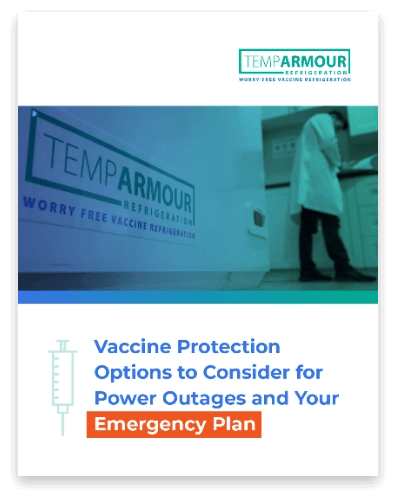
It may be time consuming, but monitoring and logging vaccine temperatures is essential when storing vaccines. In fact, monitoring vaccine storage temperature plays a key role in maintaining the cold chain of vaccines and ensuring that vaccine effectiveness is not compromised. Unfortunately, monitoring vaccine storage temperatures can take precious time and energy away from medical professionals who are already busy. But there are ways to simplify the process. Taking the time to develop a comprehensive understanding of your temperature monitoring device(s) and logging requirements early on can save you a great deal of time and stress later.
We’re providing three tips for ways to make setting up and managing your vaccine temperature logs easier and more effective. Read on.
Why Logging Vaccine Temperatures Matters
When you’re caught up in the daily routine of logging vaccines, it’s easy to lose sight of why it’s so crucial. Still, it plays a critical role in keeping the vaccine cold chain intact and keeping patients safe. Here are some reasons that logging vaccine refrigerator and freezer temperatures is important:
- It shows you when vaccine temperatures are moving into critical ranges
- It helps you identify practices or procedures that are unsafe
- It makes it easier to identify compromised vaccines
- It keeps medical professionals from administering ineffective medicine
In addition to those practical advantages, the Centers for Disease Control and Prevention (CDC) has issued several requirements for vaccine logging. Here are some of the basics that the CDC suggests:
- Monitoring the temperature of storage units at least two times a day
- Using a designated log to record temperature readings
- Inspecting storage units daily
- Rotating stock so that you use vaccines that will expire soon first
- Keeping on hand and updating vaccine storage, handling, and temperature excursion response documentation
With those key responsibilities in mind, there are simple ways you can make temperature logging much easier on staff and help avoid problems later on. Here’s how:
1. Know Which Requirements Apply to You
First, you need to find out whether there are specific vaccine storage requirements that apply to you based on where you are located or how your vaccines are funded. Applicable vaccine storage and handling requirements will also cover vaccine temperature monitoring and logs.
Logging temperatures twice a day with a min-max thermometer or using a data logger to continuously log temperatures are two common ways to monitor vaccines.
Does your vaccine supply fall into any of the following categories?
Private Stock Vaccines
If your vaccines are privately funded, a good start to ensure that you have a sound understanding of what to do to protect your vaccines is to refer to the CDC Vaccine Storage and Handling Toolkit and your jurisdiction's immunization website.
Federally Funded Vaccines
The Vaccines for Children (VFC) program is an example of a program in the U.S. that provides federally funded vaccines.
Are you a Vaccines for Children (VFC) provider? If so, be aware that the requirements for each state/jurisdiction's VFC program can differ from the next to a certain extent, although they do all tend to follow the recommendations provided by the CDC in the CDC Vaccine Storage and Handling Toolkit.
The U.S. Centers for Disease Control and Prevention (CDC) Vaccine Storage and Handling Toolkit includes recommendations and best practices for the proper storage and handling of vaccines. The toolkit has been updated annually over the past several years and is widely referenced for best practices in vaccine storage and handling. However, if you are a provider whose vaccines are federally funded (e.g., through the VFC program), ensure that you follow the vaccine storage and handling requirements as outlined by the agreement that you signed. For instance, if you are a VFC provider, you must follow the requirements specified by the VFC immunization program for your jurisdiction. Although the VFC program requirements are often very similar to the information provided in the CDC toolkit, every immunization program (whether it’s through your state or local VFC program) has its own specific requirements that providers must follow.
VFC programs require that temperature monitoring devices (TMDs) called data loggers be used to continuously monitor the temperature of stored vaccines. Some VFC programs lean towards a specific brand/type of data logger, while other programs will leave it up to the providers to choose any brand/model that meets their specified data logger criteria. VFC programs also specify how the logged data must be stored and forwarded to the VFC program.
Taking the time to really understand what your particular VFC program requires will help make things go smoothly from Day One.
Find VFC program information and links to immunization program websites here:
- CDC Vaccine Storage and Handling
- Vaccines for Children (VFC)
- VFC Information for Providers
- You Call the Shots (this web-based training covers the latest guidelines and recommendations in vaccine practice)
- VFC State Websites
Canada
If you are located in Canada, refer to your national as well as your province or territory's vaccine storage and handling guidelines. For example:
- Canadian Immunization Guide: Part 1
- National Vaccine Storage and Handling Guidelines for Immunization Providers 2015
- Alberta Health Services Standard on Vaccine Storage and Handling
- British Columbia Centre for Disease Control Communicable Disease Control Manual
- Ontario Vaccine Storage and Handling Guidelines
- Saskatchewan Immunization Manual
2. Use Helpful Vaccine Temperature Logging Resources
Let’s face it: Staff members don’t have time to research and track down all the logging tools they need. Luckily, they don’t have to.
No matter what type of temperature monitoring and logging is required by your Immunization program or your jurisdiction, you will usually find that there are abundant resources at your disposal. Your immunization program or jurisdiction's website will often provide everything you need.
Also, organizations such as the the Immunization Action Coalition (IAC) have compiled a whole range of educational materials and tools that healthcare professionals can use to effectively and safely store the vaccines in their care.
Here are some helpful aids that are available:
- Freezer Vaccine Temperature Logs in Fahrenheit
- Freezer Vaccine Temperature Logs in Celsius
- Refrigerator Vaccine Temperature Logs in Fahrenheit
- Refrigerator Vaccine Temperature Logs in Celsius
- Vaccine Storage Troubleshooting Record
Temperature monitoring device companies (e.g., data loggers, min-max thermometers, remote monitoring systems) want you to be successful with their products and virtually all have excellent videos and other resources online for learning the ins and outs of their devices.
3. The Key to Stress-Free Vaccine Temperature Logs
No matter which monitoring and temperature logging requirements you follow, you will find that although temperature monitoring devices may seem a little complicated at first, they become much simpler before long.
Once you are comfortable operating your temperature monitoring device(s), arguably the biggest factor that will determine how easily you manage your vaccines will not be the model of TMD that you have chosen, but how effectively your refrigerator or freezer keeps its temperature in range. Monitoring the accurate temperature of vaccines is crucial, but if a refrigerator or freezer does not consistently maintain its correct temperature range, then the extra administration, inconvenience, and costs related to temperature excursions and vaccine losses will cause a great deal of stress.
Your vaccine refrigerator and freezer’s ability to keep your vaccines within temperature range during regular daily use (and even through power outages) will be a key factor in how easy or difficult your overall vaccine management will be.
It is crucial that refrigerated vaccines are safely stored in the required temperature range and that temperatures are effectively monitored. However, the key to less stress, time, and resources spent is to ensure that your vaccines are stored in a refrigerator that maintains its temperature range and avoids the common causes of vaccine excursions and losses.
The TempArmour Vaccine Refrigerator is an advanced technology refrigerator that maintains consistent temperatures every day, even for up to six days through a power outage.
Our customers often tell us that the temperature in their TempArmour Refrigerator is essentially the same every morning, day after day, year after year. You will find that temperature monitoring and logging is much easier when the temperature stays in range. Its comprehensive organization system ensures vaccines are properly stored to meet best practices and requirements.
TempArmour Refrigeration believes in the importance of accurate temperature monitoring for vaccine storage and therefore includes with every refrigerator a data logger that is calibrated to meet the recommendations and requirements of the CDC, VFC and other programs. TempArmour also includes a temperature display with min-max features and the same level of accuracy and calibration as the data logger. This ensures that the temperature on the temperature display aligns with the data logger and provides an effective way to detect when a TMD needs servicing or replacement.
Make your job easier with the TempArmour Vaccine Refrigerator - Request a quote today.
How to Stay up to Date on Vaccine Storage
These tips should make it simpler to log temperatures and keep your vaccines safe. And technology advancements are making it easier to save time and energy when it comes to handling vaccines.
Want to keep up with the latest tricks, tips, resources, and processes in vaccine storage? We’re here to help. Subscribe to our blog today and get the latest updates in the industry.


